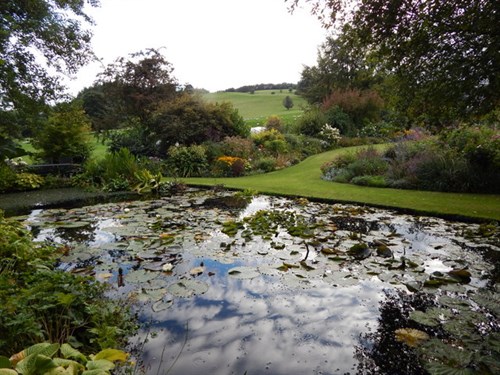A disappointing August brings an almost perfect summer to a close
Sunday, August 31, 2014
I guess it had to happen sooner or later - you just couldn't
expect to continue to wear shorts everyday of the summer! Although
it was difficult to accept at first when "normal" summer weather
returned, in some ways it was a blessing because we needed the rain
which came just in time. The much cooler weather from mid month
onwards slowed down the rate of plant growth when it looked as
though the gardening year was beginning to run out of steam. It was
relief too when the endless daily round of watering became less of
a necessity, saving a good hour and a half a day, to be more
profitably spent elsewhere in the Gardens: dead heading and weeding
were back on the agenda again and not before time!
One border which which enjoyed the wetter cooler
conditions was the north facing shade border in the Paddock
Garden
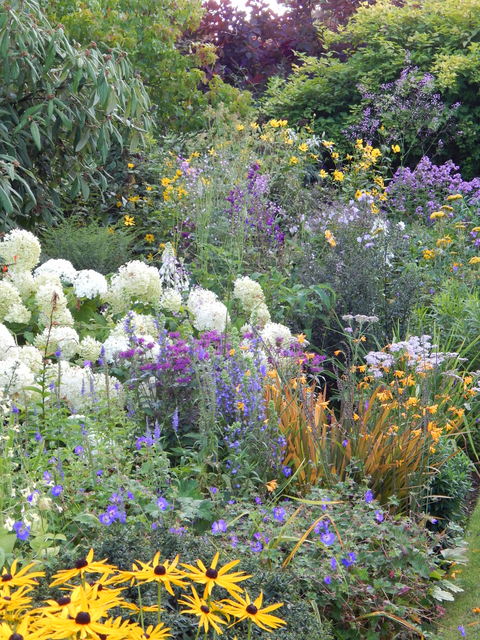
We were delighted on 22 August to play host to S4C Televison,
the Welsh medium channel who came to film the gardens for a feature
on Prynhawn Da, an afternoon magazine programme. They spent nearly
5 hours here and interviewed me towards the end of the day. I will
publish the date when the feature will be shown.

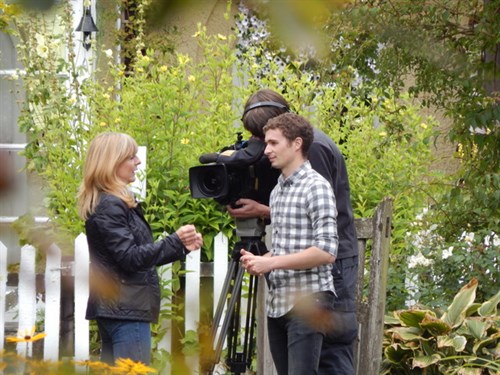
Weather
There were only 5 days above 21C, warmest dayTuesday 5th with a
max of 23C. Coldest 3C on 21st - without the cloud cover after
midnight it would have been the end for a wide range of tender
plants in the gardens. Very heavy rain at intervals throughout the
month but as in previous months very little wind. With the air flow
now in a more south westerly direction it will hopefully see the
end of potential frosts but bring us more rain. You can't
have everything!! The Met Office have confirmed it was the
wettest August for 10 years and the coldest for 21 years.
Garden update
At times there has been a distinctly autumnal feel in the
gardens with some trees and shrubs already turning colour (notably
amelanchier lamarckii and horse chestnuts) and others in full berry
production -hawthorns, roses and aronia with large crops much to
the delight of a variety of birds. Aronias have the darkest
berries, almost black, if left to maturity, but once the blackbirds
find them the plant is stripped in a few days.

Hips on rosa glauca a lovely species rose with bluish leaves and
pink single flowers in June.
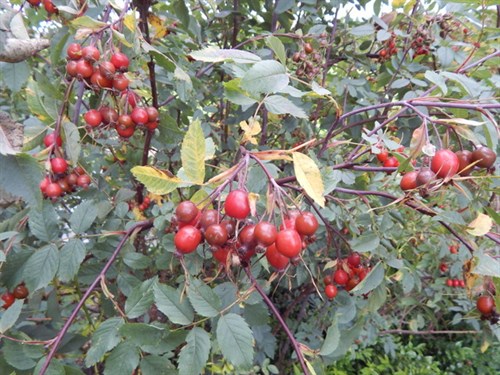
The fabulous colouring on this deeply incised palmate
leaf of ligularia przewalskii
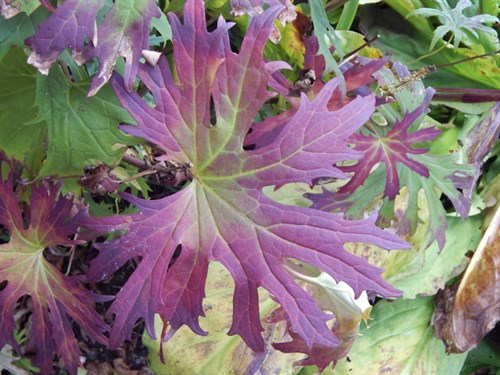
Other indicators of autumn have been a very early flowering of
some kaffir lilies, now known botanically as hesperantha, aster
nova-angliae "September Ruby" in flower on the 10 August.
There are many other asters here, now showing colour in the bud.
Amazingly after such a hot, dry summer, there is absolutely no sign
of any mildew on any of the Nova- Belgii (N.B) types that can
be badly defoliated by the mildew before they flower. On the other
hand the phlox paniculata hybrids that flowered early were
plastered with mildew from early July onwards whereas the later
flowering forms now in bloom are mildew free.
Totally mildew free leaves on aster N.B
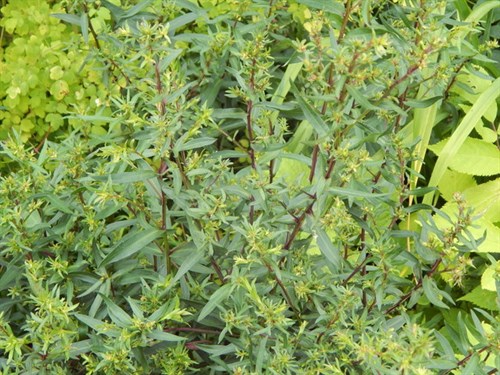
Always midew free are the "New England" (nova-angliae)
asters. This one called "September Ruby " was in flower by 10
August
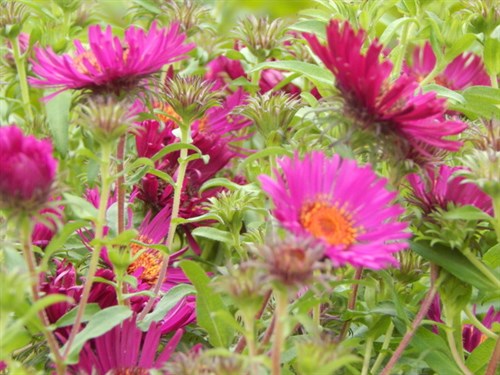
The growth on most herbaceous plants is so lush this year that I
have had to do more staking than ever, and just about run out of
metal stakes of which I have more than 500!! It may seem mad to
many of you who read this, but I am a traditionalist at heart and
love classic herbaceous borders and this is the price I more than
happily pay.
Part of the Red Border with dahlias, lobelia "Ruby
Slippers",
sedum "Purple Emperor" and providing soilidity in the
background is cercis canadensis "Forest Pansy"
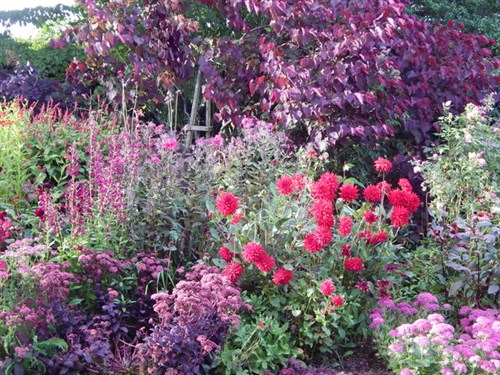
On the subject of the borders it is at this time of year that I
start to consider next year's displays and identify those plants
that need to be split or removed, the impact of the colour schemes
and the harmony of the plantings. Timely interventions like this
keep the borders fresh and the plants in the best condition. Ideas
change, better or more long lasting plants become available and
sometimes you just feel like doing something different. Some things
I will attend to in the next few weeks but others I will mark with
canes and do in the spring.
In spite of the lack of rain the lawns have looked very good and
are fed on a monthly basis, this year with 7:7:7 Growmore which
gives them a balanced dose of NPK. The autumn scarifying has just
been completed followed by top dressing with sharp sand and grass
seed to get established before the winter. I can't believe
how effective this is and the benefits are in evidence
throughout the winter and following spring. Old fashioned or not
visitors always appreciate a fine green sward, some even asking if
they can walk on it! No"Keep Off the Grass" signs here!
All is not plain sailing however - parts of the turf in
the House Garden lawns came up in lumps when scarifying, and
pulling back the turf revealed the culprits - masses of cockchaffer
grubs, the larval stage of "May Bugs" They totally devastate the
roots. All grubs removed by hand and where was the tame robin when
you neeed him?
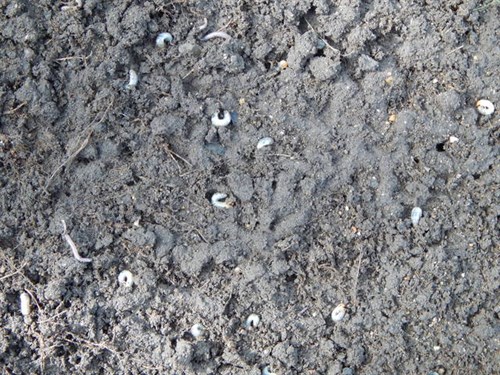
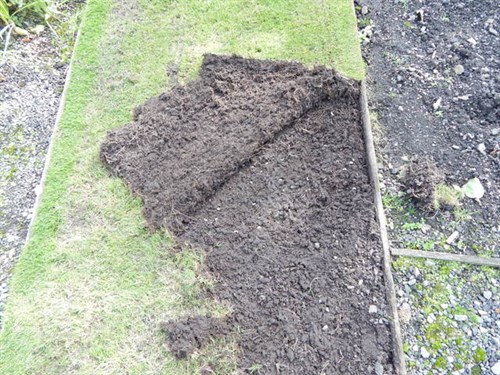
Sometimes in gardening when you have practised it for many
years, you suddenly realise that perhaps there is another way to do
something you have never seriously questioned before: take hostas
for example. They have invariably lovely flowers, some times
scented, in shades from white to deep purple, depending on the
cultivar, over a long period of time. I have always viewed the
flowering of hostas as something to be enjoyed but there is a price
to be paid in that as the flowers fade the spent blooms fall on the
leaves where they decompose and set up moulds on the leaves which
quicky spoil them, even in a dry summer like this year. The result
is that they quickly look a mess but hostas with thicker leaves are
not so badly affected. However most other hostas are capable
of looking good well into autumn if action is taken to control the
effect of the spent flowers on the leaves. Some gardeners remove
the individual flowers as they fade which is very time consuming,
others just cut off the flower stem before it starts to flower
which they consider to be essential to keep the plants looking in
good condition. Except in cases where hostas have exceptional
flowers I intend next year to cut off the flower heads before they
open. Drastic I know but I will see how it goes it goes and report
back to you. I also intend next spring, to replace with newer
introductions all the hostas in the borders at the front and side
of the house.
Devastation on leaves of hosta "Halcyon"
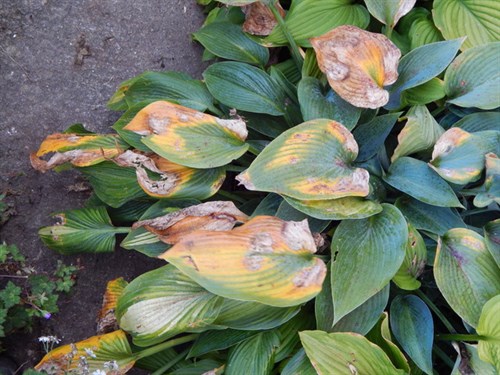
Contrast with "Night Before Christmas" which often
stays in good condition until October
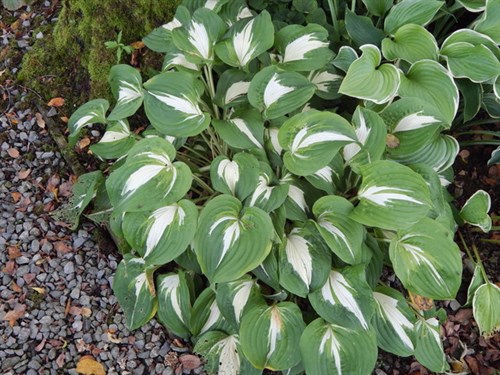
What's looking good?
Like last month, there is so much that it is difficult to
choose! To name just a few - dahlias, lobelias, crocosmias,
hydrangeas, late liles, impatiens, roscoeas, rudbeckias, chelone
obliqua, sedums, late clematis, brugmansias. A gallery of
which follows. Perhaps the greatest satisfaction however is the
bountiful vegetable harvest which is feeding us and our friends and
neighbours. Nothing beats the sweetcorn which never tastes better
than straight off the plants and into the pot before the sugars
turn to starch.
The walk to the Monet seat with salvias, crocosmias,
achillea ptarmica and agastche rogusa grouped in a flowing
and naturalistic fashion
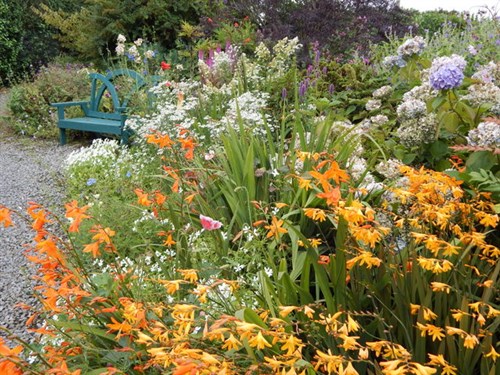
An impressive roscoea purpurea x "Red Gurkha* with dark
stems and leaves and deep purple flowers for 2 months
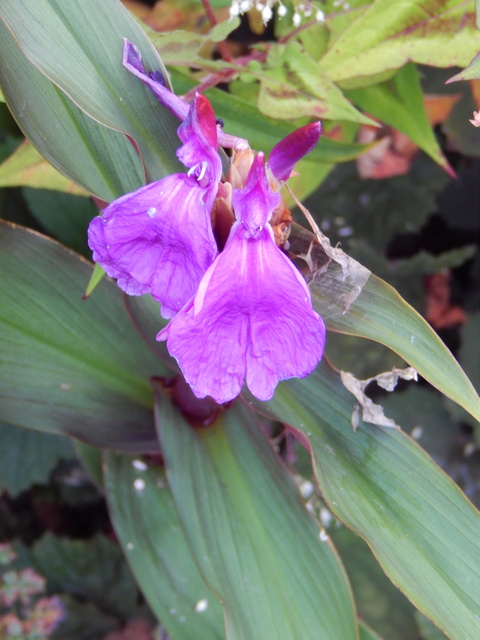
A fine stand of sweetcorn

And the best bit of all the succulent and sweet cobs
dripping with butter!
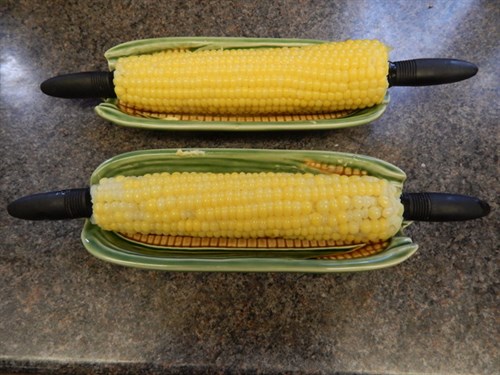
Brugmansia suavolens in the large tunnel with 30 blooms
on a much branched plant 8 feet tall

A late and very prolific flowering on most of the shrub roses is
an added bonus, the more so as there is little in the way of rust
or blackspot to spoil the overall appearance
Always much admired by visitors is rosa "Rhapsody in
Blue" a good repeat cluster flowered type
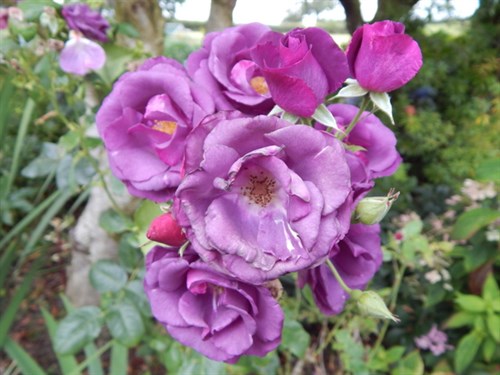
On the basis that one picture is worth a thousand words it's far
better to let the plants speak for themselves so here are some
more pics. of the very best
A fine crop of Sturon onions grown from
sets

A fine stand of 80!! winter cabbages including in order
of cropping "Resolution", "KIlaxy", "Marabel" a January King Type,
"Tundra" several varieties of late winter savoys
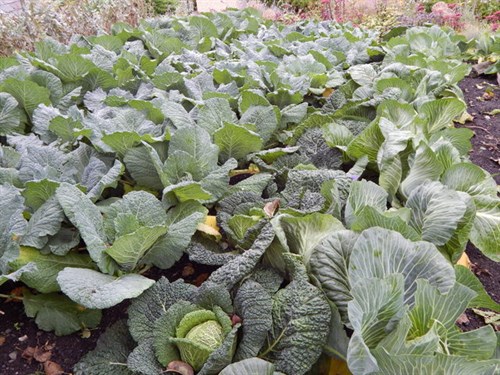
A very acceptable crop of potatoes considering the late
planting lack of rain and early onset of blight. 3.5 cwt of spuds
harvested including Cara, Maris Piper, Blue Belle, Cara but once
again the best crop and largest tubers came from the good old
faithful Desiree my favourite all rounder

Only 2 varieties of tomato grown this year (35 plants in
all) but when they are as good as "Rosada", small plum, and
"Gourmet", standard size, you need no others
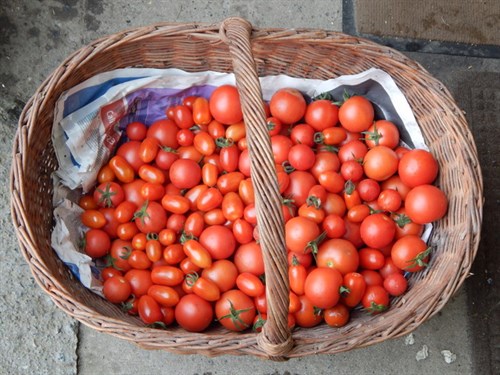
Hydrangea "Preziosa" continues to delight with its ever
changing colours on the fading flowers
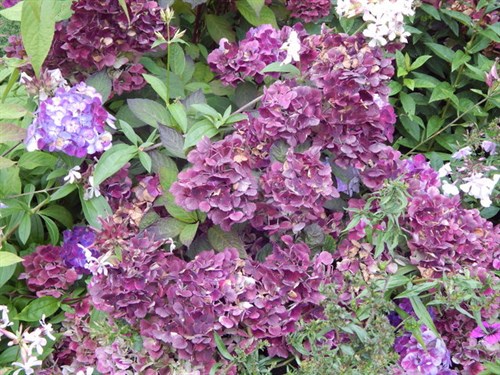
Hydrangea "Tokyo Delight", very refined for a
macrophylla type with a fine balance of fertile flowers and sterile
ray florets
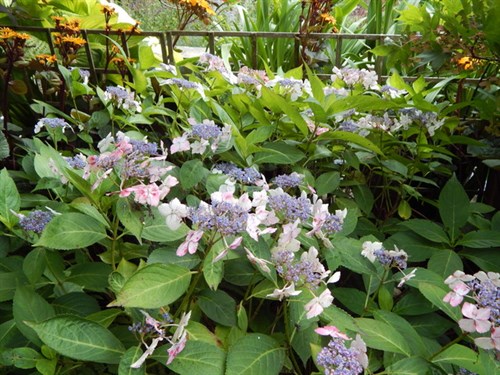
Paniculata group hydrangeas are some of the easiest and
most reliable forms to grow and we have 10 different varieties
here. This one is "Vanille Fraise" which starts white but ages to
deep pink like a combination of vanilla and strawberry ice cream.
It has a pink eyed/white phlox, lobelia syphyllitica and monarda
"Snow White" as border companions. I hope you will agree they make
a pleasing combinbation
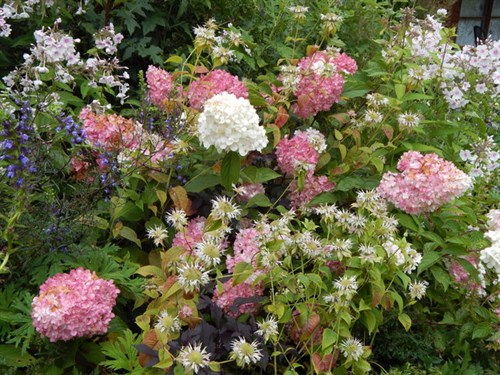
A more unusual form of hydrangea but not uncommon
is h. involucrata, a smaller form with interesting flower heads,
which begin the process with a single balloon shaped flower bud
that opens to a more familiar lacecap head.
This one is a recent introduction being a cross between h.
involucrata and h. aspera Kawakami Group. Here it a is partnered
with persicaria "Inverleith" which perfectly picks up the slightly
peachy pink of the hydrangea flowers
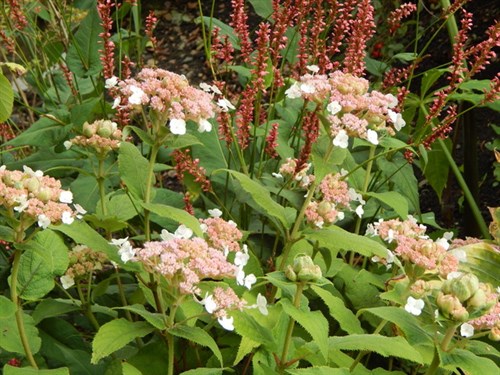
And this one is h.involucrata "Oshima", a smaller, more
compact form than the one above
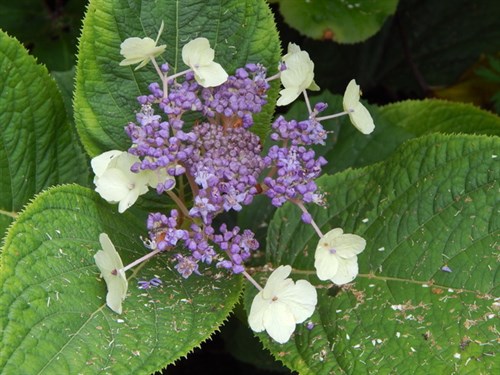
Clematis tangutica "Lambton Park" a long flowering form
to 15 - 20 feet

Clematis Purpurea Plena Elegans climbing into a
variegated Portugese laurel
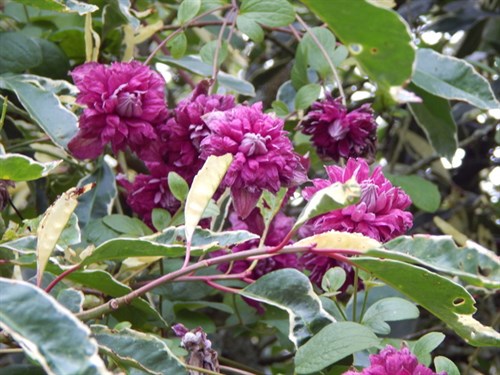
Doing exceptionally well is "Heather Herschell" a
scrambler rather than a climber which grows to about 6 feet. Ideal
for clothing early summer perennials which have faded.
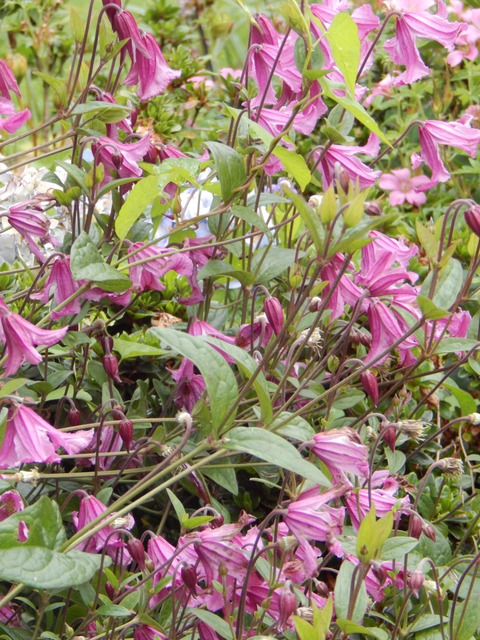
And a simple very small flower of the species clematis
texensis, the only red species in the genus clematis which by
crossing has give rise to "Princess Diana", "Gravetye" ,"Duchess of
Albany" and many others all have which have much larger flowers in
this shape on more vigorous plants
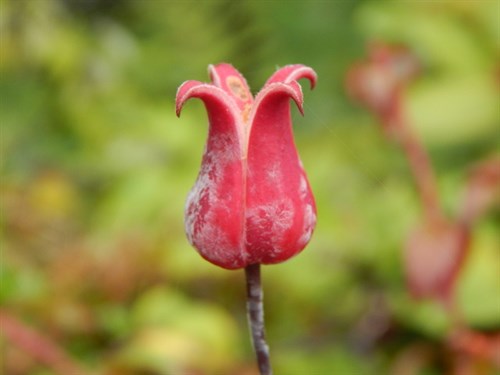
Wildlife and countryside
Where have all the winged insects gone? The butterflies
especially are now very scarce only a few tortoishells and peacocks
have been in evidence, in spite of a rich variety of open flowers
for them to feast upon. The good news is that the scarcity also
extends to cabbage whites!! Dragonflies are rarely seen and
of all things at this time of year there are hardly any wasps.
Plenty of bats at twilight (pipistrelles for the most part) and
many swallows and martins starting to mass on the telephone lines,
a sure sign of impending autumn.
It has been good after an absence of some years to see hedgehogs
again in the gardens. One mature adult and several juveniles. On a
dark night I even tripped over one in the long grass of the
adjoining field - good job I didn't land on the spikes as they are
really sharp.
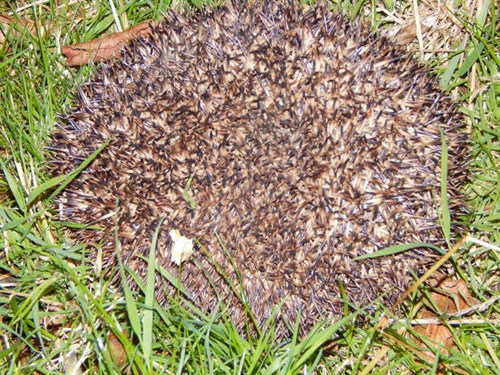
There have been several sightings of a goshawk, a brooding and
menacing presence and an impressive flier. Other notable birds this
month have included kingfishers, dippers, ravens, and a good many
red kites after the surrounding fields have been cut for the grass
harvest. There are several young robins which get bolder everyday,
following me wherever I go. Their breasts are slowly turning red
and I asked the young daughter of of one of our farmer neighbours
what the Welsh name is for robin and without hesitation she replied
it was robin goch, the equivalent of robin redbreast. They are
great company all year round and such characters.
Hope it isn't tempting fate but there are far less rabbits in
evidence so all the protective fleece has at last been removed from
the vegetables. Grey squirrels are very active with such an
abundant harvest of nuts on the native hazels.I just hope they
leave alone the ripening later crop of sweetcorn cobs to which they
are particularly partial.
Peahen and chicks on the lawns at Powis
Castle
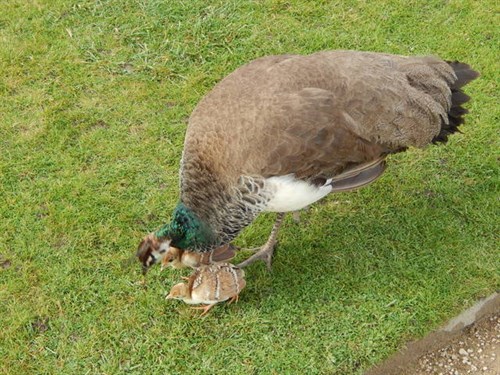
Like most men the brightly coloured peacocks are more
intersted in going out with boys and discussiing the football
results!!
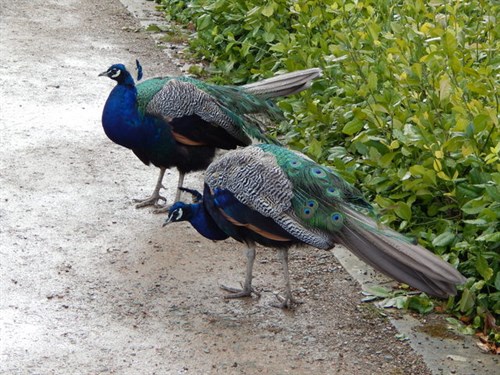
Visits and visitors
Our NGS garden opening year came to an end with a visit from
volunteers at Cowbridge Physic Garden on the 26th. It was an
excellent visit with so many knowledgeable plantspeople (all ladies
which was very nice for me!!) and a great way to finish; a special
thanks ladies for the generous gifts you presented to us.

This year we have raised £1,235 for the charities supported by
the NGS and had just under 200 visitors. Every one of the
visits was in fine dry weather which is surely a record in the 15
years we have been opening the Gardens.
Next week we commence our 11th season of autumn and winter talks
to clubs and societies with a visit to old friends at Bwlch
Gardening Club. If you would like us to give a talk to your club
please get in touch. Our current range of talks can be found under
the heading "Talks and Teas" on the website.
During August we continued to find opportunities to go garden
visiting ourselves and during the month went to National Botanic
Garden of Wales, Bristol University Botanic Garden, Powis Castle,
Pan-Global Plants, a really excellent nursery in Gloucestershire
and Derwen Garden Centre in Welshpool, part of Dingle Nurseries the
largest nursery group in Wales.
National Botanic garden of Wales
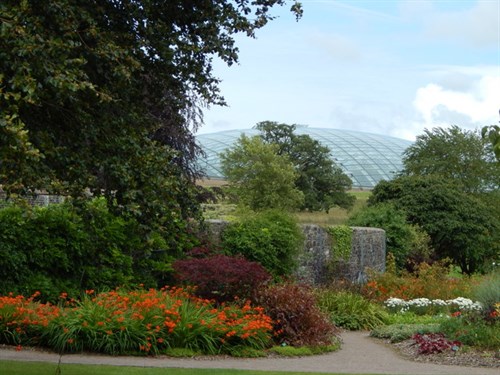
A tropical waterlily in the hot glasshouse
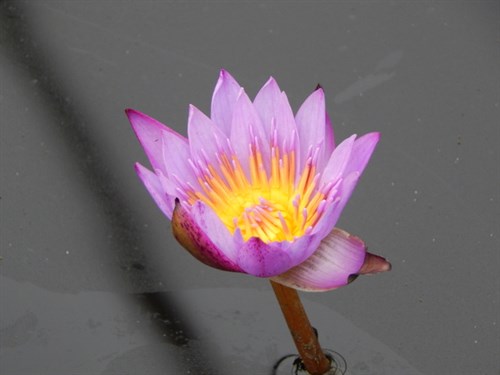
A fabulous stand of kangaroo paws in the Australian
section of the Great Glasshouse
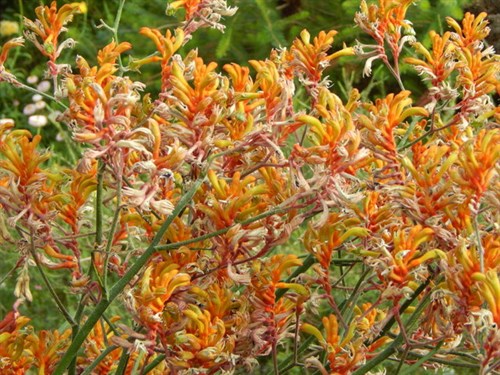
And in the monocot section of the double walled garden a
banana in full bloom outdorrs having benfitted from the warm
summer

Bristol University Botanic Gardens. Showing the
evolution of plants many of which are still around today, some over
500 million years old - no wonder I am so in awe of
plants!
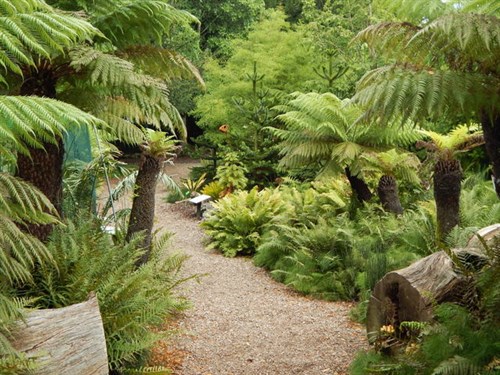
The giant amazonian waterlily named for Queen Victoria
and grown in hot glasshouses in the UK for 200 years. Huge leaves
that reputedly can easily carry the weight of a child
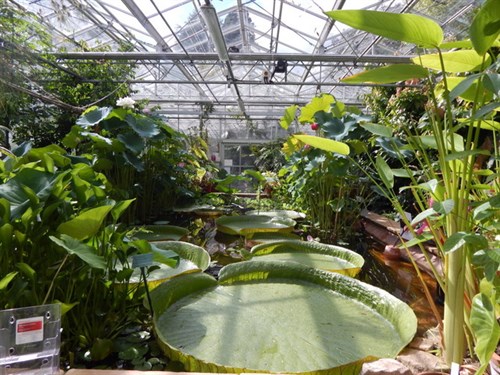
And growing with them in water a shot as bath is the
fabulous sacred lotus nelumbo nucifera, the white bowl lotus, the
height of which is quite breathtaking
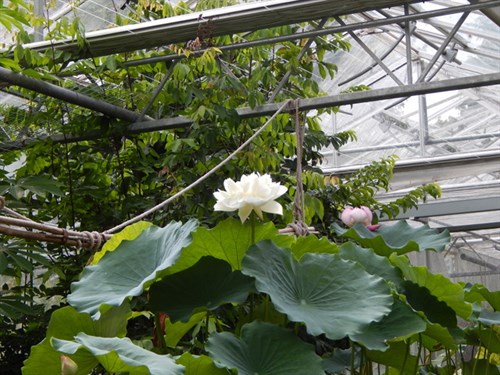
A superb stand of agapanthus inapertus "Midnight", the
darkest blue I have ever seen and now on my "must have plants"
list!!
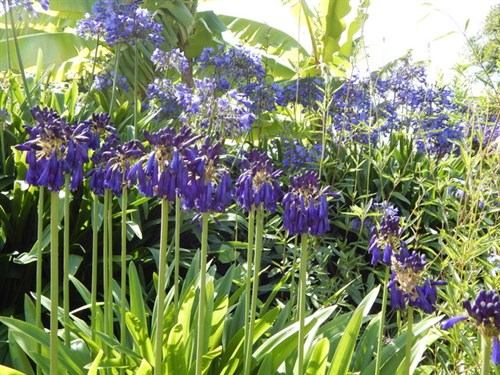
Some pics of Powis Castle which need no text to add to
their majesty
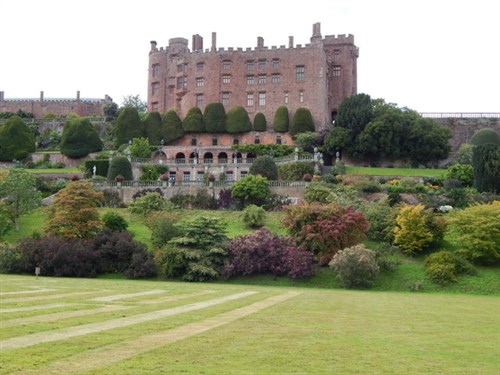
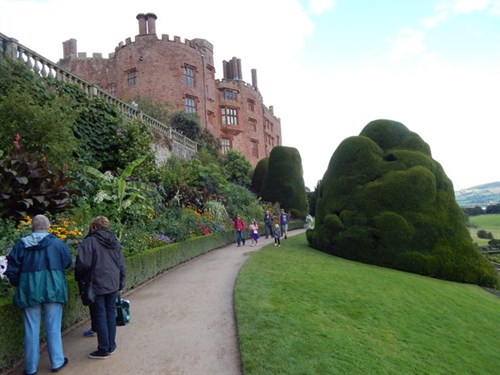
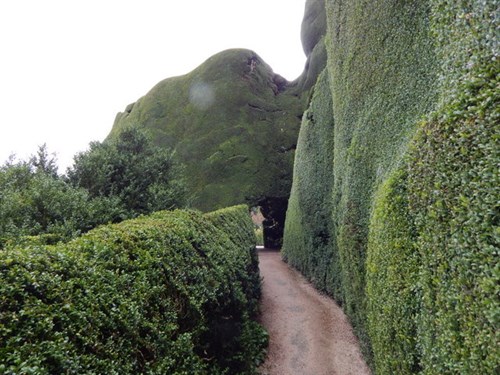
We had also planned to have a short break in Devon to celebrate
Moira's birthday intending to visit Keith Wiley's amazing Wildside
Garden, The Garden House, RHS Rosemoor and the long established and
legendary Marwood Hill near Barnstaple. Unfortunately the break was
even shorter (just 3 hours) than we planned as the pick up
broke down (alternator failure) in the services at Exeter!

So we have to wait for our next break in late September to
Malvern Autumn Show ( a perennial favourite) followed by a
dahlia festival at Kelmarsh Hall in Northamptonshire. After that it
is the slow decline towards late autumn and the darker nights, wood
cutting and keeping the fires stoked. At least we have had a proper
summer this year, the memories of which will sustain us throughout
the winter.
Just when I thought I ahd finished this marathon News
item there was the most fabulous cloud formation that cried out for
a picture
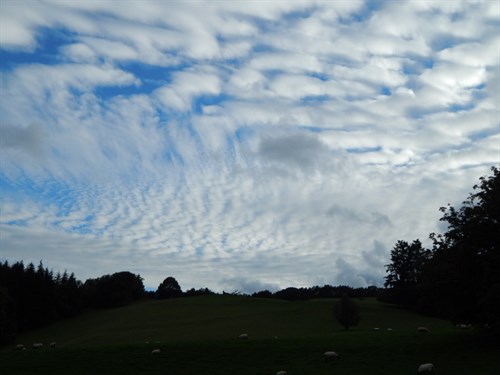
And it was almost as impressive reflected in the
"Paddock Pond"
